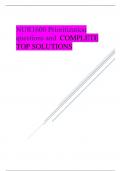Samenvatting
Summary for the course evolutionary psychology (P_BEVOLPS)
- Vak
- Instelling
This is a detailed summary of the course Evolutionary Psychology (course code: P_BEVOLPS) at the Vrije Universiteit Amsterdam. This summary provides you: - tips for the exam, - an explanation of all the discussed slides, - a summarization of all the important theories and hypotheses during ...
[Meer zien]







